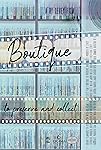Eye For Film >> Movies >> Boutique: To Preserve And Collect (2024) Film Review
Boutique: To Preserve And Collect
Reviewed by: Jennie Kermode

The idea of collecting films no doubt seems odd to many people today. Why fill up your home or garage with piles and piles of discs or cassette tapes which you need special, increasingly hard-to-find equipment to play, when you could just stream what you want? The trouble is that (as we are continually reminded when compiling our weekly Stay-at-home Seven) many films are not available to stream, or in any kind of digital format; and when they are, they can disappear at a moment’s notice. It used to be the case that films came out in the cinema, or screened at festivals, and then just disappeared. If you were lucky, you’d get to see them on television four years later, and then they’d be gone again. Whilst streaming gives us access to more at any one time, individual films face the same risk today.
Ryan Bruce Levey is not just a director – he’s also a distributor and PR, and he knows the industry inside out, so he’s the perfect person to explore this subject in a film which formed part of the 2024 Frightfest slate. It begins by addressing the advent of the VCR and how being able to watch films repeatedly at a time of one’s choosing permanently altered the way that people related to them, before going on to reflect on different formats, on the emergence of specialist labels and on what all this meant for the recovery, restoration and preservation of titles which would otherwise have been lost forever.

Let’s be clear: not all these titles were great art, though some of them certainly were. Early on, Criterion cornered the market in high quality foreign language titles, scouring the archives of Europe and beyond to find everything they could that fit their brand. Other companies, like Something Weird, specialised in grindhouse and quirky sex films. Fans had to try to figure out which obscure labels would deliver what they wanted, and although these were pre-internet days, word of mouth still got around surprisingly fast, enabling savvy curators to build up up their businesses fast.
Not everyone caught on so quickly. “Is it a fad or for real?” asks an Eighties news presenter, speaking of the home VCR, like a rabbit gazing in curiosity at a pair of headlights. We rattle through the unlucky contenders that missed out on market domination, with aficionados briefly extolling the merits of RC8 video discs and laserdiscs. There’s a look at how commentaries and special features changed that relationship again, and how they also changed the public’s perception of who constituted an authority on film, with the likes of Kier-La Janisse, Sarah-tai Black and Anya Stanley coming to the fore – something which would, over time, also change the conversation in which filmmakers themselves were engaged.
The particular importance of the video revolution to women, people of colour and LGBTQ+ people is also addressed here. By enabling the preservation of outsider classics like Daughters Of The Dust and The Watermelon Woman, as well as independent early 20th Century films made to counter white supremacist narratives, it makes a vital contribution to the preservation of histories and provides evidence to support counter-arguments when people are told that concern about their rights is a wholly new topic.
Levey’s enthusiasm for his subject is infectious but over the course of an hour and a quarter it also gets tiring. The relentlessly bouncy music can be a bit much, and more ebb and flow would make the film easier to digest. This is a small issue, though, in light of its thoroughness. It’s taking a lot on and there would be room to go into several of these subjects in more depth, but as a starting point for exploring this important yet curiously neglected social phenomenon, it delivers very well.
Reviewed on: 24 Aug 2024
















